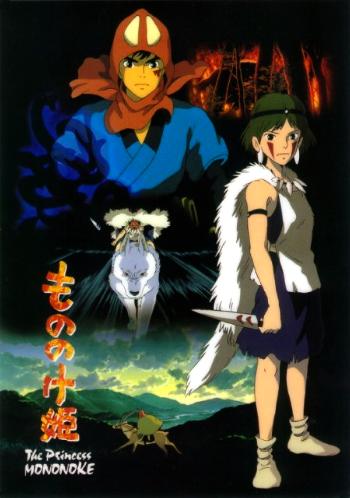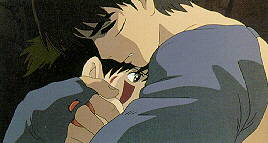Black Horizon Anime
Cultural Views on the Movie
Princess Mononoke
Note: This article was actually written as an assignment for a sociology class. The purpose of this article is to compare and contrast American culture to the ancient Japanese culture in medieval times where the movie, Princess Mononoke, takes place
By the way, just to let you know I got an A on this paper so HA!!
Article by Marwah (A.k.a. Shinigami)
"In ancient times, land lay covered in forests, where from ages long past, dwelt the spirits of the gods. Back then, man and beast lived in harmony, but as time went by most of the great forests were destroyed. Those that remained were guarded by gigantic beasts who owed their allegiance to the great forest spirit. For those were the days of gods… and of demons…"
This was the prologue to the opening scene for the movie, Princess Mononoke. Set in medieval Japan, a time of shoguns and samurai, it is a story about a bloody battle between man and the forces of nature. The main hero, prince of the Emishi village, Ashitaka, travels on a journey "to see with eyes unclouded" in order to lift the curse that fell upon him after killing one of the forest gods. On his journey, he finds himself caught in a struggle between the humans who seek to destroy the forest and the animals who endeavor to save what is left of it. At the same time, it is a movie that displays a view of life in medieval Japan and gives a, seemingly fictional, glimpse of its culture back then. Studying this movie shows how much Japan’s medieval society differed from the West’s contemporary society based on its culture and beliefs.
American culture in this day is mostly based on the advancements in technology, the emerging twenty first-century family, and the country’s vast growing economy. Today’s American society is far more focused on technology among many other factors. Where computers affect everything, technology plays its role in having such a great impact on the country’s condition and well being. American society has grown dependent on computers and Internet to file all sorts of documents, connect with the rest of the world, and explore what was never previously brought to their knowledge. However, none of this existed, or could even be imagined in the days of medieval Japan. To them, technology of this level was inconceivable and was never a concern to their society at all. Their cultural values, beliefs, and traditions were modest and simple.
According to how Japanese culture was portrayed in the movie, the people of that time believed in gods and demons, physical lords whom they could see and speak to. At first, this does not appear peculiar since there were many other cultures who believed in the very same things even till this day. What seems odd, however, is that these people believed in lords that were represented by "gigantic beasts," extraordinarily large animals that lived in the forests. Knowing how Western society basis their opinions on logic and rational thoughts, this is obviously something that would be considered to them as superstition.
In addition, it seemed that they also believed they could foretell the future and predict ones fate by using stones. This was done by throwing the stones and studying their positions and arrangements, just as an astrologist would study the positions of the stars and planets. This was shown in the scene when the wise woman of the village told Ashitaka that, according to the stones, he was cursed with an infection that would spread out to his entire body, eating his flesh and bones, then ultimately kill him.
After learning his fate, Ashitaka cuts his hair and leaves the village. It was also in this scene that the wise woman pronounced him as dead to his people. This is the one scene that leaves many American audiences confused as to why Ashitaka is considered dead when he is clearly standing before his people alive and well, despite the curse. The reason for this is that in ancient Japanese culture, hair signifies a person’s mortal remains, cutting it means that one has now joined the ranks of the dead. The American culture of today is not familiar with such beliefs and would not understand this segment of the movie without prior knowledge of this. Again, noting western society’s way of reason and logic, they would simply look at this in a cynical manner describing it as irrational, incredulous, and superstitious.
The stereotypical views of men having more dominant roles in Asian, or Japanese culture, is easily brushed aside once viewers are introduced to Lady Eboshi, leader of Iron Town. According to the villagers of Iron Town, Lady Eboshi changed the condition of the town that had remarkably improved. Likewise, there seems to be no sign of women’s oppression at all. The women of Iron town speak openly, freely, and very bluntly amongst themselves and in front of the men. One example is when Toki, one of the women of the town, openly scolds her husband, Kuroko, for being incapable of driving the oxen due to his injuries after Ashitaka rescued him. Toki candidly chides her husband saying, "I wish the wolves had eaten you, then maybe I could have found a real husband." She even mocked Gonza, who worked under Lady Eboshi as captain of the guards, accusing him saying that he is "always strutting and throwing your weight around once the danger’s over. You never do a lick of work around here." Gonza’s only reply was comically childish when he said, "but that’s unfair and untrue." Apparently, the women of this town were not afraid to speak freely and the men seem to have no objection to it. Similarly in American society, women enjoy these same rights and privileges that in many other cultures are forbidden, even till this day.
The women of Iron Town may seem quite rude and disrespectful to outsiders. Their crude and vulgar attitudes may have others perceive them as repulsive an unappealing. Members of American culture might even see them to be this way. However, this is not the case. In reality, these women are charming ladies who lead hard lives. In their culture, both men and women share certain responsibilities to help their town to flourish and prosper. The men go out to sell iron in order to bring back food and rice, while the women work pumping the bellows at night to make more of the iron that pays for the rice.
Militaristically, both men and women play their roles in defending Iron Town. When San, better known as Princess Mononoke or princess of all the forest gods, ghosts and demons, attacked the village wanting to kill Eboshi in revenge for destroying the forests and killing the animals, every man and woman took arms to fight back. Furthermore, Eboshi was planning on developing rifles that were light enough for the women to carry when fighting. This culture made sure to allow all of its members, both men and women alike, to fight any opposing forces that would threaten their town and people. The same can be said for today’s American culture, which presently allows men and women to join the army in order to defend and fight for their country.
One distinct variation between this culture and American culture is their theories on certain preconceptions. For example, noble figures such as monks and priests are usually portrayed to Western society as selfless charitable people who do nothing but good for others. It would be surprising for them to see a monk who is actually a rogue. This was the case in medieval Japan. Many in that culture were aware that wandering monks were not always to be trusted. In the movie, the monk known as Jiko Bou appears in the beginning as a good honest man who assists Ashitaka in buying some rice from a nearby village and giving him directions to his destination. The audience finds out later on that he is in fact a villain who seeks to take the forest spirit’s head. He is the actual cause of the major conflict in the movie. To have a monk as a scoundrel is uncalled for and unexpected in American culture, unlike the Japanese who know that some monks can be shady characters.
As viewers watch this movie, they realize how many mysterious factors are regulated into the story: enchanting forests filled with mythical creatures of lords, ghosts and spirits, superstitious beliefs of joining the dead by cutting one’s own hair, and living amidst gods and demons. None of these can relate to American culture, but what does relate them are the roles the women play in both cultures.
Through the use of the media, viewers and audiences from various backgrounds can come to understand and relate to other societies with different cultural values and traditions. Ironically, it is also the media that plays a role in forming these stereotypes. Nevertheless, as seen with Princess Mononoke, recognizing cultural similarities and differences can eliminate the usual stereotypes and misconceptions brought about by incredulous judgments.
Copyright © 2000 Black Horizon Anime
Web design by Shinigami (Mouri)
All rights reserved to their respective owners (mostly us ^_^)
Best viewed with Internet Explorer or Netscape 4.0 or higher
Revised: April 02, 2001 .
|



















